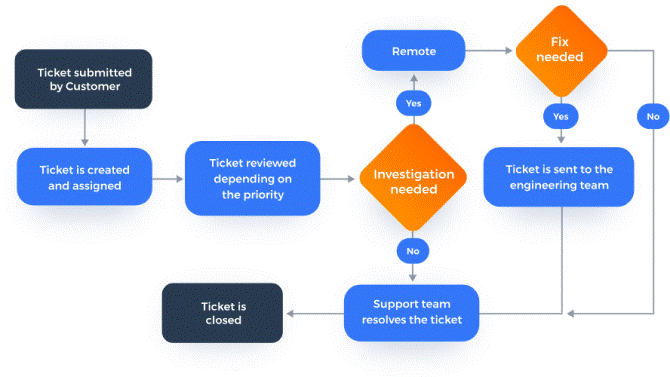BPI Project Tools - Information Processing Flowcharts
Business Process Improvement projects are become the most widely accepted means of bringing about changes in the ongoing business operations with an aim to remove redundancies, to adapt new technology, to increase efficiency as well as to bring about the required change in process in line with the business requirements.
BPI processes aim to increase the efficiency of operations as well as make them effective to realize the business goals, objectives and enhance customer satisfaction too.
BPI Projects are undertaken in all or any of the operational areas in an Organization. Appropriateness of choosing a particular process or department is made by the senior management and the Business Heads in keeping with the business needs and the customer expectations.
Sometimes the managements do sponsor BPI projects for increasing internal operational efficiencies as well as to reduce wastage too.
The success of any BPI project is dependent upon several factors including the interest and commitment of the Senior Management to the project as the main sponsors. Another important factor that contributes to the quality of the project as well as the outcome is the training and skill level of the BPI task team or the PIT Team.
The Project Implementation Team would need to be thoroughly trained in the BPI concept and methodology as well as in the BPI tools including Statistical Analysis tools and methods, Use of Quality principles and methodology as well as usage of Flow Charts.
Flow Charts are by far the most effective tool that is used extensively in all fields and all areas of business operations and Organizations. Flow charts when used to depict any process can capture the picture better than using words to describe the process.
Pictorial depiction is far more effective than words. Therefore using flow charts to map the business process helps one to understand simple to complex processes and its operation at micro level, macro level as well as understand the interdependencies with other processes, identify the inefficiencies, obstacles and roadblocks as well as establish the criteria and parameters to measure the process efficiency and effectiveness.
There are different kinds of flow charts that are used for various purposes. Some of the most commonly used flow charts are: Block Diagrams, ANSI Standard flow charts, Functional flowcharts, Functional Time Line flow charts, Geographic Flow Charts & Information Processing View flow charts etc.
All of the flow charts use what is known as Standard Symbols to map the processes. It is important for the BPI Project team to be conversant with the standard symbols to be able to prepare the flow charts as well as to interpret them.
ANSI standard symbols are used globally to indicate operations, movement, transportation, decision point, as well as activities like inspection, storage etc. Every activity and task can be mapped using the standard symbols.
Information Processing Flow Chart
Apart from the normally used process flow charts and geographic flow charts, Information processing flow charts are used to follow through the information flow as against any physical activity or task that is mapped using other types of flow charts.
When you analyze any particular process, you will realize that the process is a combination of tasks performed by employees processing physical resources as well as information received through various sources. Therefore information becomes one of the major areas that need to be looked into to improve efficiencies. Employees who work on processes are store houses of information and knowledge.
Needless to say that information, knowledge and the people managing, communicating and using information form the core of the process.
Another important factor that needs to be remembered is that whenever people are involved in communication and exchange of information, the process becomes complicated and vulnerable.
Furthermore the geographic location, the communication methodology and tools etc play an important part in process efficiency. Therefore information flow charts become important tools to be able to identify the critical information centers, to standardize and control the elements that process the information and provide output as per the process.
Example of Information Flowchart

| ❮❮ Previous | Next ❯❯ |
 Related Articles
Related Articles
- Process Adaptability Improvement
- Flow Chart as BPI Tool
- Different Types of Flow Charts
- Flow Charts and QC Tools
- Working through BPI Project
Authorship/Referencing - About the Author(s)

The article is Written and Reviewed by Management Study Guide Content Team. MSG Content Team comprises experienced Faculty Member, Professionals and Subject Matter Experts. We are a ISO 2001:2015 Certified Education Provider. To Know more, click on About Us. The use of this material is free for learning and education purpose. Please reference authorship of content used, including link(s) to ManagementStudyGuide.com and the content page url.